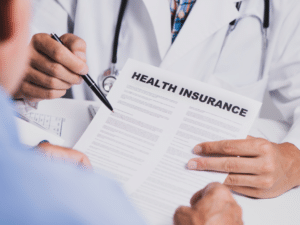Cystic cysts are common and can affect anyone at any age. Most cysts are benign but can be uncomfortable and worrisome. They are sacs that can form in different parts of the body. Usually filled with fluid, air, or other substances. Cysts can be small and go unnoticed or big and cause discomfort or symptoms. Some are harmless, others need medical attention.
What is a Cyst?
Definition and Explanation
A cyst is a closed sac or capsule that contains fluid, semi-solid, or gaseous material. It is a common skin condition that can occur anywhere on the body, including the face, neck, back, and torso. Various factors cause cysts. Such as blockages of sebaceous glands, or sweat glands. As well as infections, injuries, or genetic conditions.
Cystic Cysts Overview
What is the Most Common Cystic Cyst?
The most common type of cyst is a sebaceous cyst. An epidermoid cyst, often mistaken for a sebaceous cyst, is a benign, encapsulated nodule filled with keratin that can appear on various body parts such as the face, neck, and trunk. Understanding the signs, symptoms, and potential treatment options for these cysts is crucial for effective management. Other common types include ovarian cysts and ganglion cysts, which form on the wrist or hand. A pilar cyst is a specific type of noncancerous skin cyst that typically forms under the skin, primarily on the scalp, due to protein buildup in hair follicles.
What is a Common Cyst in Women?
Ovarian cysts are the most common type of cyst in women. These cysts develop on the ovaries during the menstrual cycle. While most ovarian cysts are harmless and disappear on their own, some can cause pain, discomfort, or complications such as rupture or torsion.
What are the 3 Types of Cystic Cysts?
-
Sebaceous Cysts – Typically found on the face, neck, or back. After the sebaceous gland becomes blocked then they form.
-
Ovarian Cysts – In women these form on the ovaries and are related to the menstrual cycle.
-
Ganglion Cysts – These form on joints or tendons, usually in the hands or wrists.
How Long Do Cysts Last?
Most cysts are harmless and go away on their own within a few weeks or months. Some cysts can persist or grow and need medical attention.
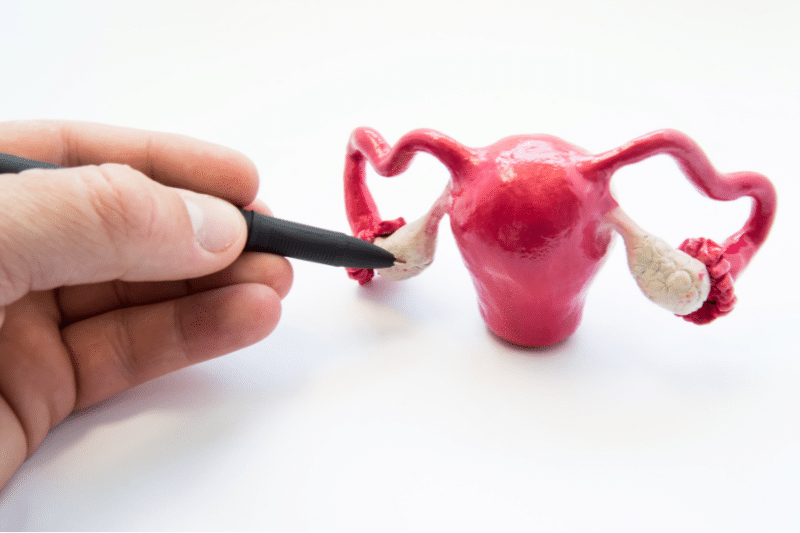
Cystic Cysts – Early Signs and Causes
What Causes a Cyst?
Cysts can occur for many reasons. The main cause of a cyst is a blockage in a duct or gland that prevents fluid drainage. When this happens the trapped fluid forms a cyst. Hormonal changes, infections, and genetic conditions can also cause cysts. Injuries or trauma to the skin or underlying tissue can also cause cysts to form.
A pilonidal cyst is a common skin condition that forms in the crease at the top of the buttocks, often as a result of loose hair being pushed back into the skin.
According to American Society of Colon and Rectal Surgeons (ASCRS), over 70,000 cases of pilonidal cysts are treated annually in the U.S.
What Causes Cysts on the Skin?
Cysts on the skin are also known as sebaceous cysts and are caused by blocked hair follicles or glands. The blockage traps oil, dead skin cells, and other debris in hair follicles and causes a skin cyst to form. Skin cysts can appear on the face, neck, scalp, or back.
What Causes Cysts on the Back?
Back cysts especially sebaceous cysts occur when the sebaceous glands are blocked. Sometimes trauma or injury to the skin can cause a skin cyst to form on the back. Poor hygiene, excessive sweating, and skin conditions like acne can also increase the chances of skin cysts being on the back.
What Causes a Person to Get Cysts?
Cysts can be caused by:
Hormonal Fluctuations
Hormonal imbalances especially during puberty or menopause can cause cysts.
Infections
Bacterial infections like staph infections can cause cysts.
Chronic Inflammation
Long-term skin irritation or inflammation in the body can cause cysts.
Blocked Ducts
When sebaceous or sweat glands get blocked they can cause cysts.
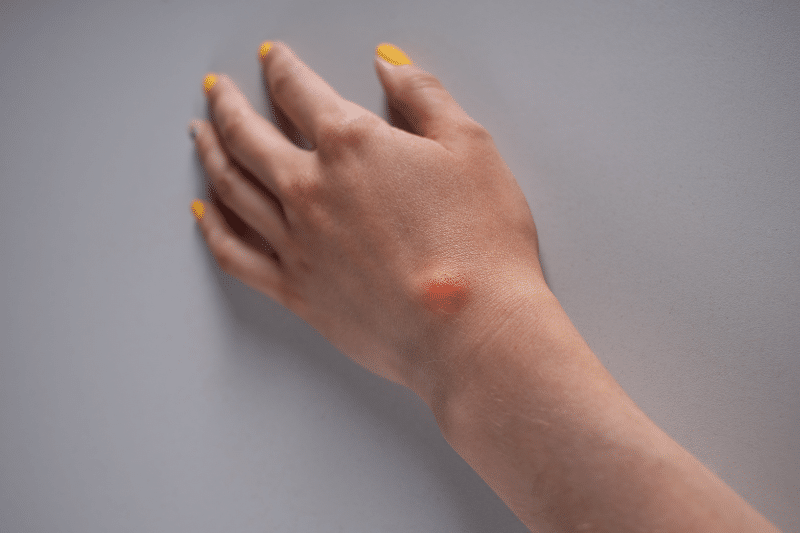
What Are Epidermoid Cyst?
Hair follicle cysts, also known as epidermoid cysts, are a type of cyst that forms when a hair follicle becomes blocked. They are usually small, painless, and filled with a thick, cheesy material called keratin. Hair follicle cysts can occur anywhere on the body. But most commonly found on the face, neck, and back.
What is a Cystic Lump?
A cystic lump is a soft, smooth lump beneath the skin that is filled with fluid or other material. It can feel tender or sore to the touch but is often painless. While most cystic lumps are benign, it is essential to get them checked by a healthcare provider to rule out any serious conditions.
Why Do People Get Cystic?
People get cystics due to a variety of reasons, including genetics, hormonal imbalances, or lifestyle factors such as diet and hygiene. In some cases, medical conditions such as polycystic ovary syndrome (PCOS) can lead to the formation of cysts throughout the body.
Where Do Cysts Form?
Cysts can form anywhere in the body but most commonly in:
-
Skin (sebaceous cysts) – Face, neck, back.
-
Ovaries (ovarian cysts) – In women of childbearing age.
-
Wrists and Hands (ganglion cysts) – Along joints and tendons.
Can Cysts Spread to Other Parts of the Body?
Cysts don’t spread to other parts of the body. But if a cyst becomes infected or bursts it can cause complications in internal organs. In rare cases, cysts associated with certain medical conditions like polycystic kidney disease and breast cancer can affect multiple organs.
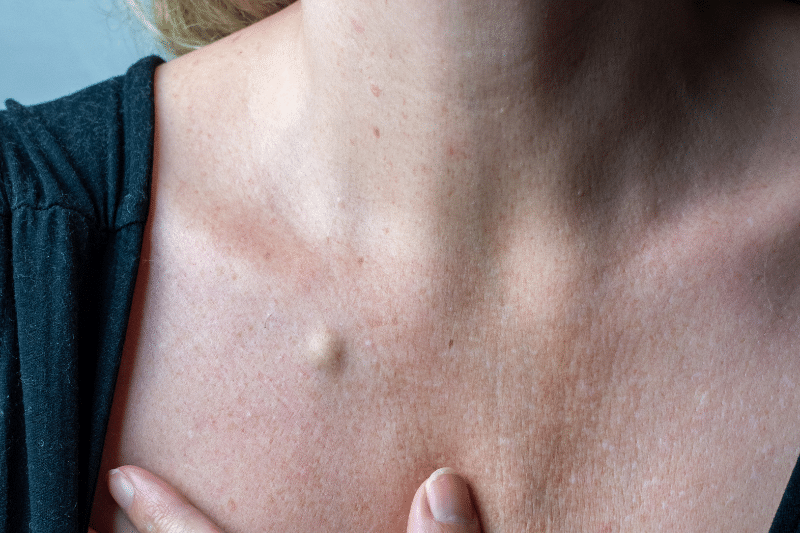
Types of Cystic Cysts
Cysts come in various forms and can develop in different parts of the body. It’s essential to understand the different types of cysts and their characteristics. Case reports often highlight clinical and imaging features, as well as complications related to a ruptured epidermal inclusion cyst, focusing on specific instances of rupture and the subsequent impacts on patients.
According to NIH study in 2023, Around 7% of women worldwide will experience ovarian cysts at some point in their lives.
What is a Sebaceous Cyst?
A sebaceous cyst – a noncancerous lump under the skin filled with a cheese-like or oily material. These benign cysts usually found on the face, neck, or back and caused by blocked sebaceous glands.
What Are the Early Warning Signs of an Ovarian Cyst?
Ovarian cysts often cause no symptoms and go unnoticed. However, when they do cause symptoms, they can include:
-
Pelvic pain or discomfort.
-
Bloating or swelling in the abdomen.
-
Pain during intercourse.
-
Irregular menstrual cycles.
If any of these symptoms occur, it is crucial to consult a healthcare professional for evaluation.
What is the Main Cause of Ovarian Cysts?
Ovarian cysts develop during the menstrual cycle when a follicle (sac) that holds an egg fails to release the egg or doesn’t dissolve after the egg is released. Hormonal imbalances, pregnancy, or conditions such as endometriosis can also cause ovarian cysts.
According to American College of Obstetricians and Gynecologists (ACOG), approximately 10% of women in the U.S. will undergo surgery for ovarian cysts during their lifetime.
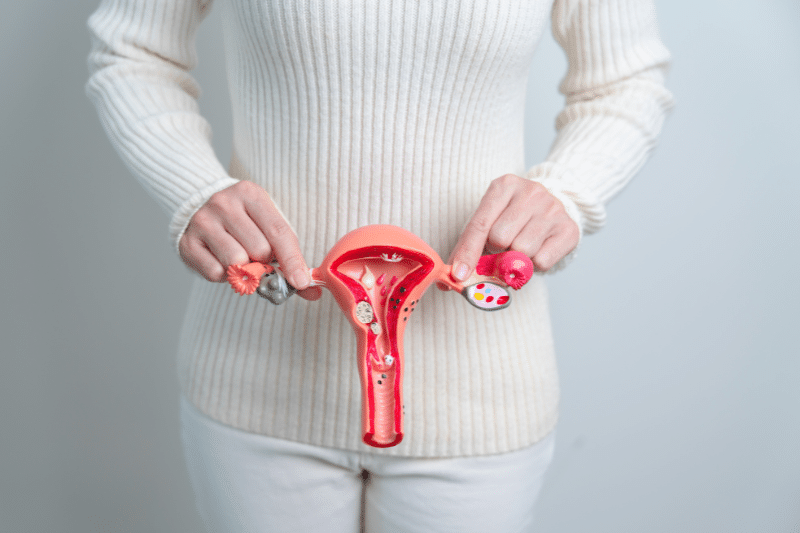
What Are the Different Types of Cysts Found in Women?
Women commonly experience various types of cysts, including ovarian cysts, breast cysts, and Bartholin’s cysts. A dermoid cyst is another type of cyst that can be found in women, often requiring surgical removal. These cysts can cause discomfort and may need medical attention to prevent complications.
Ovarian Cysts
Related to the menstrual cycle.
Breast Cysts
Fluid-filled sacs that can develop in the breasts, often benign.
Bartholin’s Cysts
Form in the Bartholin glands near the vaginal opening.
What Type of Cysts Need to Be Removed?
Not all cysts need to be removed. However, cysts that are infected, causing pain, growing rapidly, or suspected of being cancerous may need surgical removal.
What is a Cancerous Cyst?
While most cysts are benign, some cysts can be cancerous. Cancerous cysts are more likely to be solid rather than fluid-filled, and they can grow or spread quickly. A biopsy or imaging tests like ultrasounds or MRIs determine whether a cyst is cancerous.
What is the Difference Between a Cyst and a Tumor?
Cysts are typically fluid-filled, while tumors are solid masses of tissue. Both are different cysts that can benign or malignant. Regardless doctors advise to have further medical testing to determine the nature of the lump.
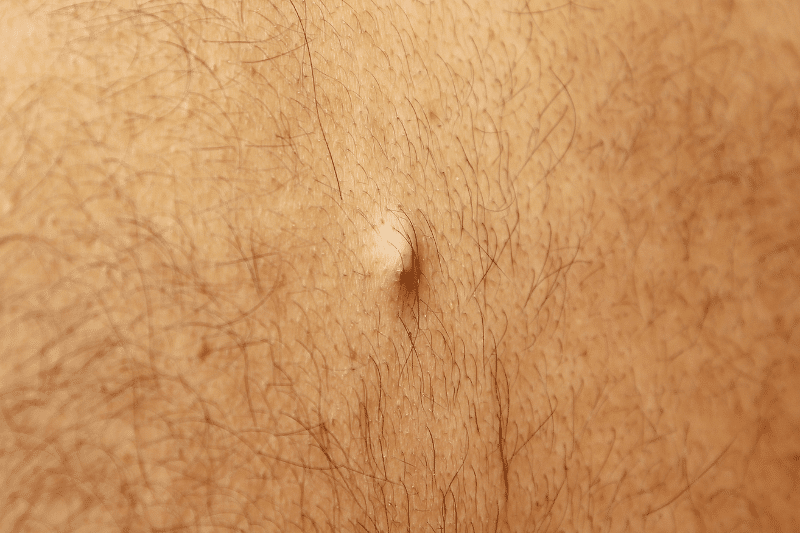
Cystic Cysts – Causes, Symptoms, and Risk Factors
Understanding the risk factors is key to managing and preventing them.
Are Cysts Caused by Stress?
Stress doesn’t cause cysts but can trigger underlying conditions that cause cysts to form such as hormonal imbalances.
Why Am I Getting So Many Cysts?
If you’re getting multiple cysts it could be due to many reasons including hormonal imbalances, genetics, poor skin hygiene, or underlying medical conditions. Consult with the healthcare provider for through examination.
Is a Cyst Caused by Stress?
Stress doesn’t cause cysts but can worsen skin conditions like acne leading to sebaceous cysts.
Can Diet Cause Cysts?
Some foods especially those high in sugar, processed ingredients, or unhealthy fats can worsen acne which can lead to cysts. A healthy diet with anti-inflammatory foods can reduce the risk of cysts.
How Genetics Contribute to Cysts?
Genetics can predispose you to certain types of cysts like polycystic kidney disease or ovarian cysts. If there’s a family history of cysts, you’re more likely to get it.
Cystic Cysts – Signs and Symptoms
The symptoms of cysts can vary depending on the type and location of the cyst. Common signs and symptoms include:
-
A small, painless lump or bump on the skin
-
A fluid-filled lump or sac that can be felt under the skin
-
Redness, swelling, or inflammation around the cyst
-
Pain or tenderness to the touch
-
A foul odor or discharge from the cyst
-
A ruptured cyst can cause redness, swelling, and pain
It’s essential to note that not all cysts cause symptoms, and some may not be noticeable until they become large or infected. If you suspect you have a cyst, it’s crucial to consult a healthcare professional for proper diagnosis and treatment.
Why Am I Getting Cystic?
Cystic acne or cysts in different parts of your body could be due to hormonal changes or genetic predisposition. An underlying condition like polycystic ovary syndrome (PCOS) may also be the culprit.
Why Am I Getting Cysts on My Neck?
blocked sebaceous glands or ingrown hairs cause cysts on the neck. In some cases, infections or skin conditions like severe acne, may cause cysts on the neck.
Are Hormones Linked to Cysts?
Yes, hormones are a big factor in cysts especially ovarian cysts in women. An imbalance in estrogen, progesterone, or testosterone can cause cysts.
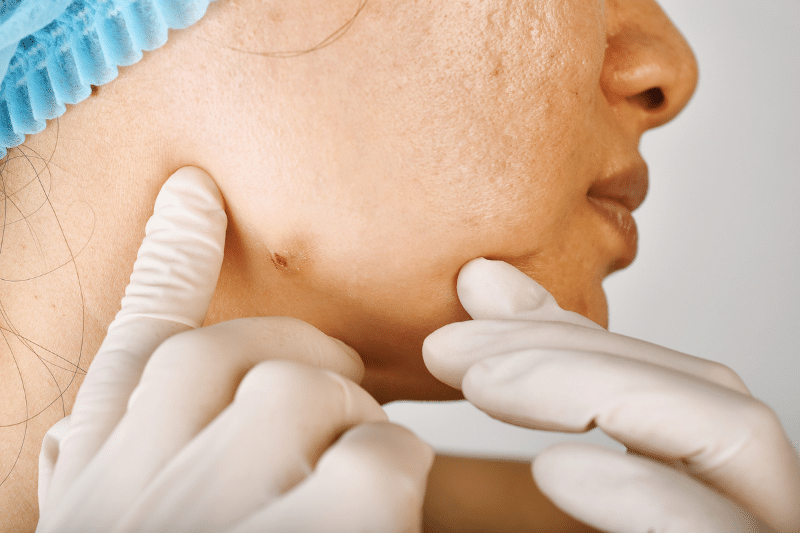
Cystic Cysts – Diagnosis and Identification
Knowing the symptoms and recognizing the cysts early is key. A ganglion cyst is a benign lump that develops on or near joints or tendons, especially in the wrists and hands. Caused by joint or tendon irritation and may present with symptoms of swelling, discomfort, or pain if they grow and press on surrounding structures. Treatment options are drainage or surgical removal depending on severity and impact on daily activities.
How Do You Know if a Lump is a Cyst?
A cyst feels like a small round or oval bump under the skin. It may be soft or firm and most cysts move when pressed. If unsure see a doctor for a thorough diagnosis.
What Does a Cyst Look Like?
Cysts can look different. Some are small and almost invisible while others can grow big and red or swollen. Most are smooth to the touch and filled with fluid.
What Does a Cancerous Cyst Look Like?
Cancerous cysts are firm, grow fast, and may be irregular or vary in size and shape. Furthermore, it may associated with pain or changes in the skin above the cyst.
How Do I Know I Have a Cyst?
If you have a lump under your skin that’s soft and moves when you touch it, it could be a cyst. For internal cysts like ovarian or kidney cysts, you may feel discomfort or pain in the area.
Is a Cyst on the Back Cancerous?
Most back cysts especially sebaceous cysts are benign. But any lump that grows fast or changes should evaluated by a doctor to rule out cancer.
Can Neck Cysts Become Cancerous?
While most neck cysts are harmless, some can become cancerous. Thyroglossal duct cysts and branchial cleft cysts, for example, examined by a doctor if they become large, painful, or change in appearance.
Can Imaging Tests Like Ultrasound Detect Cysts?
Yes, imaging tests such as ultrasounds, MRIs, or CT scans are common diagnoses to detect cysts. These tests help determine whether a breast cyst itself is fluid-filled or solid. In addition, crucial in diagnosing whether it’s benign or malignant.
How Can You Tell if a Cyst is Infected?
An infected cyst will often become red, swollen, and painful. You may also notice pus or fluid draining from the cyst. If you suspect an infection, it’s important to seek medical attention.
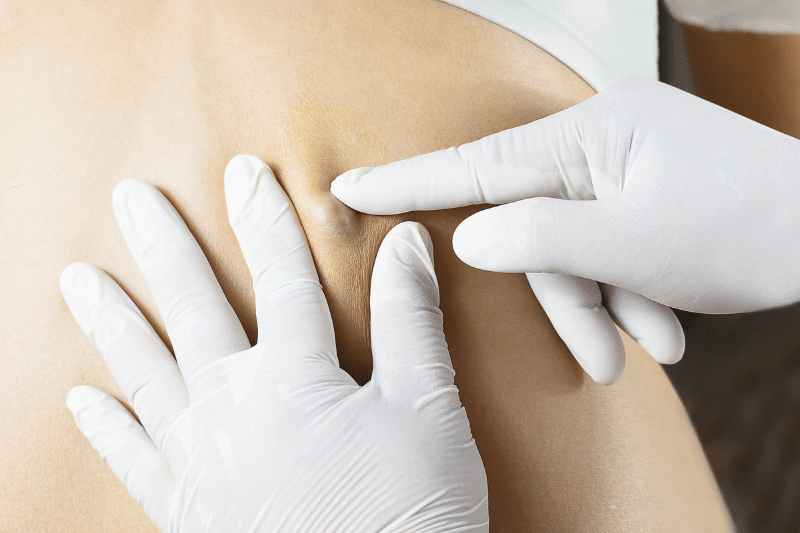
Cystic Cysts – Treatment and Management
Most cysts are harmless and resolve on their own, but others may require medical treatment or removal.
Do Cysts Go Away on Their Own?
Many cysts, especially smaller ones, disappear on their own within a few weeks to months. However, larger or persistent cysts may need medical treatment.
Can a Cyst Go Away on Its Own?
Yes, in many cases, cysts go away without treatment. If the cyst is small and not causing discomfort, a doctor may recommend a wait-and-see approach need treatment.
What Type of Cysts Need to Be Removed?
Doctors recommend those cysts, particularly causing symptoms. As well as growing fast, or showing signs of infection or malignancy. Including ovarian cysts, big sebaceous cysts, or cysts in sensitive areas.
How Do I Get It Removed From My Neck?
Doctors surgically remove cysts on the neck through excision. Moreover, makes a small cut and removes the cyst whole. In some cases, the doctor uses drainage techniques before before removal.
How Do I Get Rid of a Cyst Lump on My Back?
Healthcare professionals remove sebaceous cysts on the back through minor surgery. The doctor makes a small cut and then remove the cyst. However, drain the cyst first for smaller cysts.
How Do I Get Rid of Cysts on My Back?
Surgeons treat sebaceous cysts through excision to remove cyst contents. If the cyst is small then the surgeon may drain it but this increases the chance of recurrence.
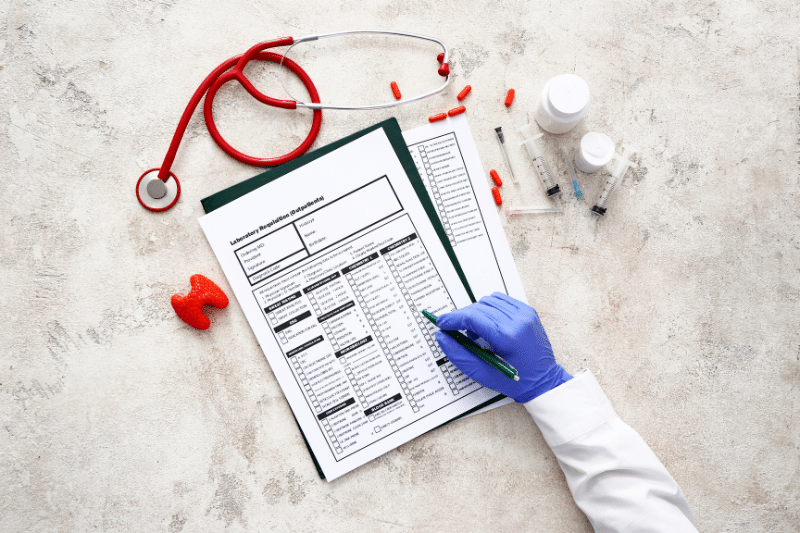
What Medical Treatments Are Available to Remove Cysts?
Medical treatments for cyst removal include:
Surgical Excision
The procedure completely removes the cyst.
Aspiration
The content of the cyst drained.
Corticosteroid Injections
Used to reduce inflammation and shrink the cyst.
Laser Treatment
Laser treatment is one of the minimally invasive cyst removal options for treating cysts that form under the skin. Typically not used for all types of cysts. It includes:
- Ablative Lasers.
- Non-ablative Lasers.
- Fractional Laser.
- Pulsed Dye Lasers (PDL).
How Should I Get Rid of a Cyst?
If the cyst is causing pain or discomfort, it’s best to consult a healthcare provider. They may recommend a procedure to remove or drain the cyst. Over-the-counter pain relievers and warm compresses may also help alleviate symptoms.
How to Remove a Cyst?
Doctors remove it through surgical excision, making an incision, and removing the cyst. In some cases, surgeons use a minimally invasive procedure called aspiration to drain the cyst.
What Do You Do if a Cyst Pops Under the Skin?
If a serious cyst forms or pops under the skin, clean the area thoroughly with antiseptic to prevent bacterial infection there. Apply a sterile bandage and consult a healthcare provider for further treatment.
What Home Remedies Can Help Shrink Cysts?
Warm compresses can help shrink cysts by promoting blood flow to the area, which aids in healing. Over-the-counter pain relievers like ibuprofen can help with discomfort. However, it’s essential to consult a doctor before trying home remedies.
What is the Recovery Time After Cyst Removal Surgery?
Recovery time after cyst removal surgery typically takes about one to two weeks. The area may be sore, and the doctor may recommend keeping it clean and avoiding strenuous activity.
Can Cysts Come Back After Removal?
Yes, cysts can return after removal, especially if only the contents of the cyst were drained and the cyst wall wasn’t fully removed.








